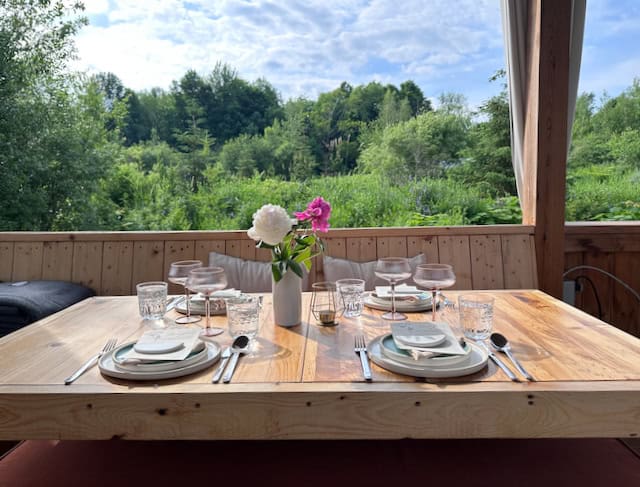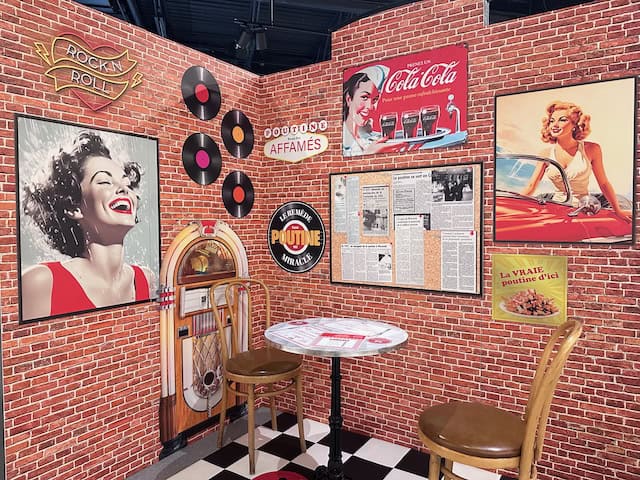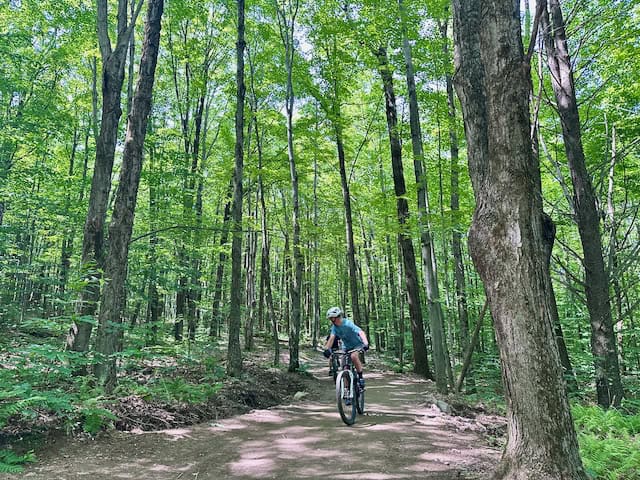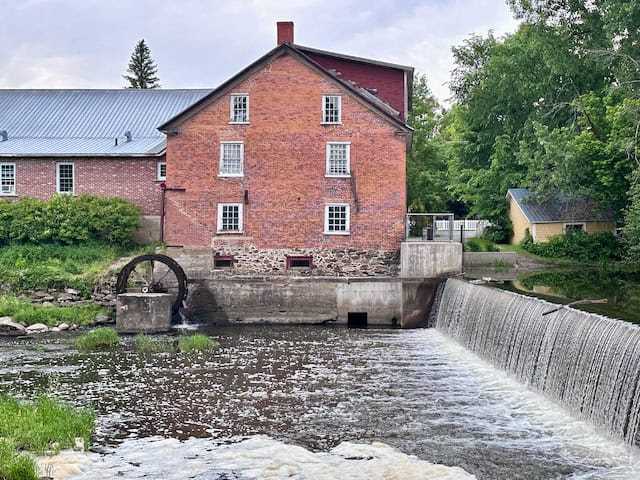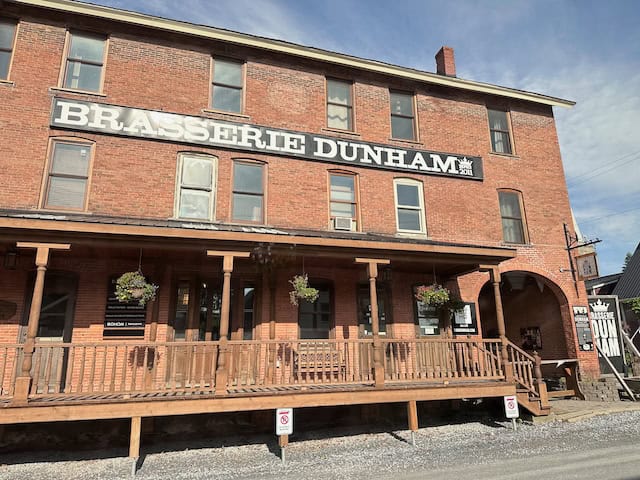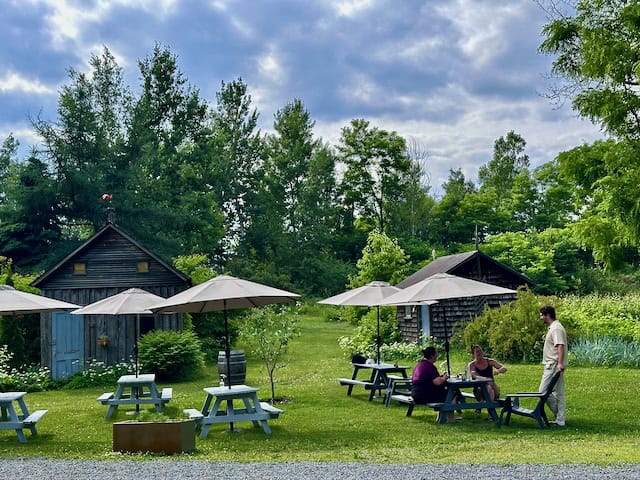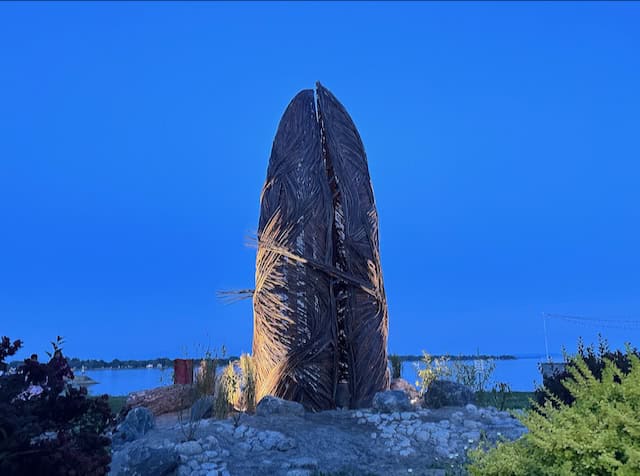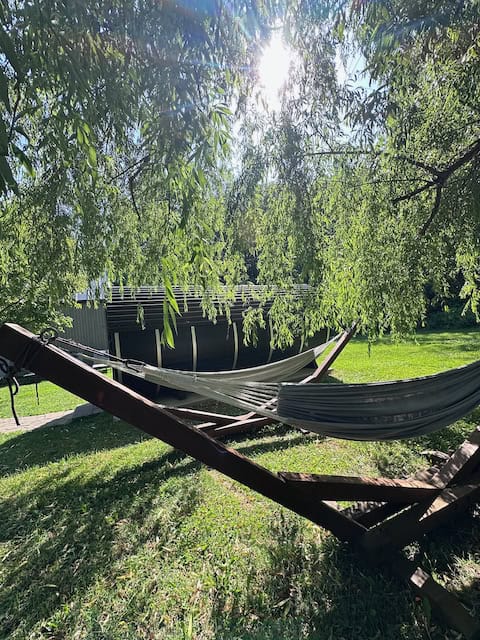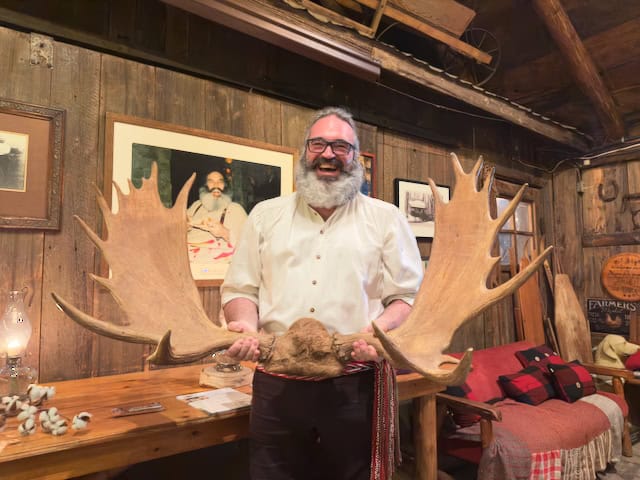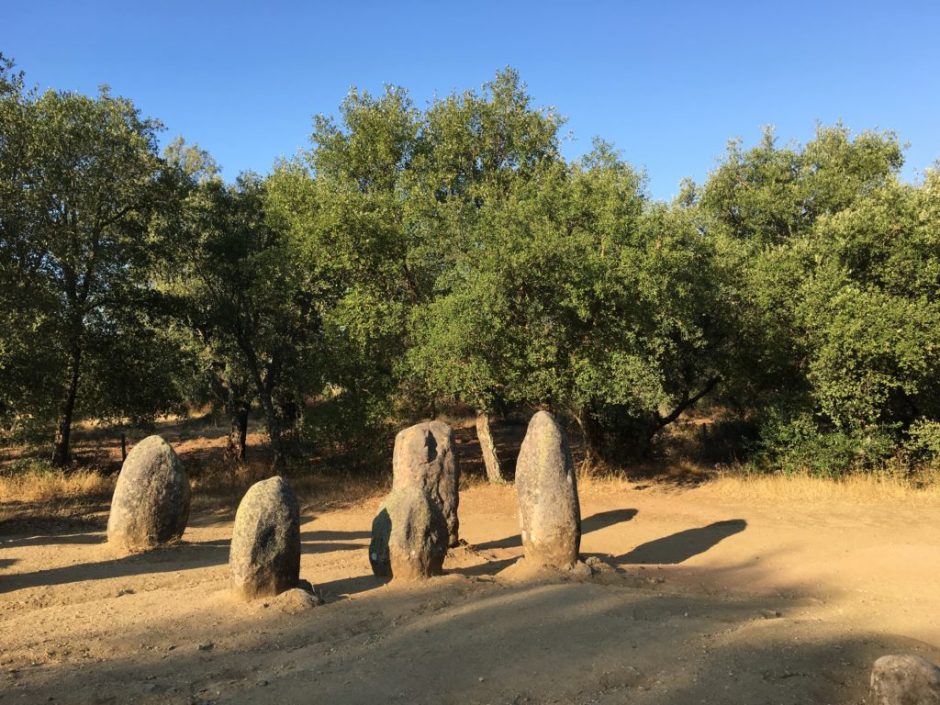It doesn’t normally take five days to drive from Québec City to Montreal, but we weren’t on an ordinary trip. Hosted by Bonjour Québec, we were on an epicurean journey. Our culinary experiences included a visit to a traditional sugar shack; farm-to-table dining where the farm was literally outside the door; visits to local wineries as well as an award-winning cidery; a monumental market with an educational farm and butterfly pavilion; a mountain hike and more. While we only had one night in each location, I’d strongly recommend settling in and enjoying Southern Quebec’s warm hospitality more fully when you visit this sensational region in Canada. Here are some of the highlights:
Wine and Cheese? Oui, Merci!
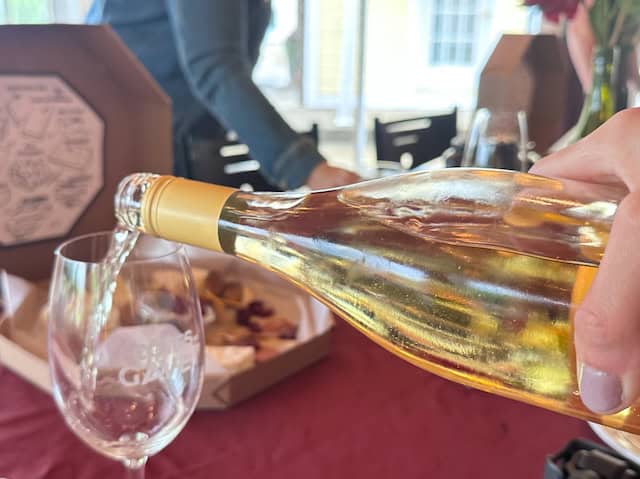
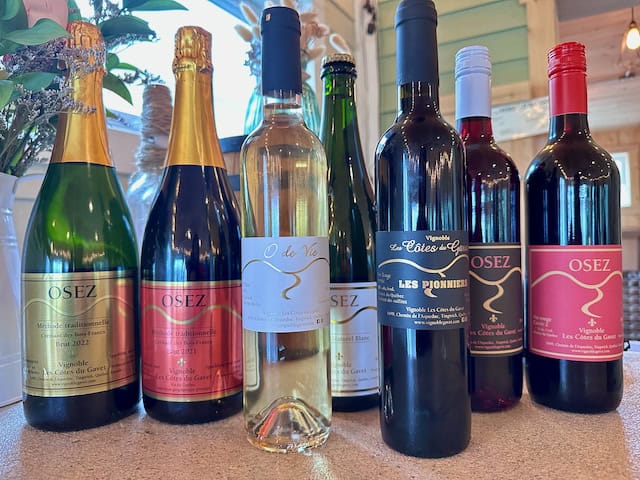
Canada may not be the first country that springs to mind for wine tourism, unless you think of the Okanagan Valley in British Columbia with 284 wineries and 4,486 hectares of vineyards, or Ontario, known for it’s world-class ice wine. Québec, with 125 wineries and 775 Hectares dedicated to viticulture, is Canada’s third largest wine region and a growing force in the country’s wine industry.
Our journey began with a visit to Vignoble Cotes du Gavet, a family-run, award-winning winery in Centre-du-Québec. The Marchand family has been making wines here since 2023 from vineyards that have been producing since 2000. We sampled several of their wines including their pet nats (petillant naturel). I was particularly partial to the sparkling rose. The wines, under both Cotes du Gavet and Osez labels, are made using local hybrid grape varietals like Frontenac Blanc, Frontenac Noir, Louise Swenson, Sabrevois, Petite Pearl and Crimson Pearl.

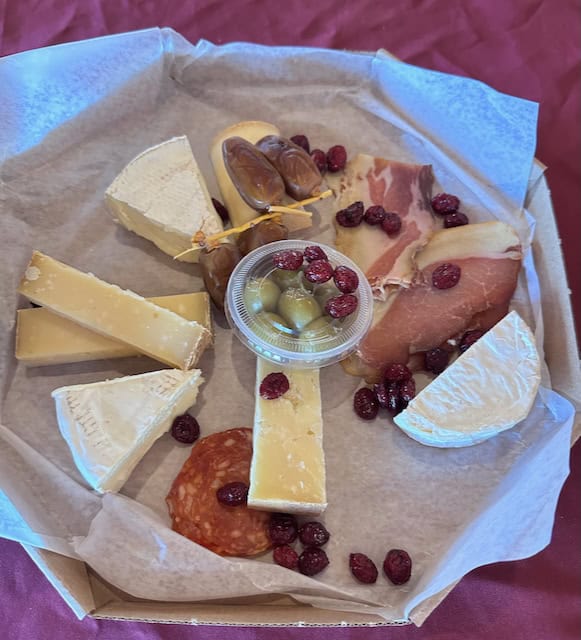
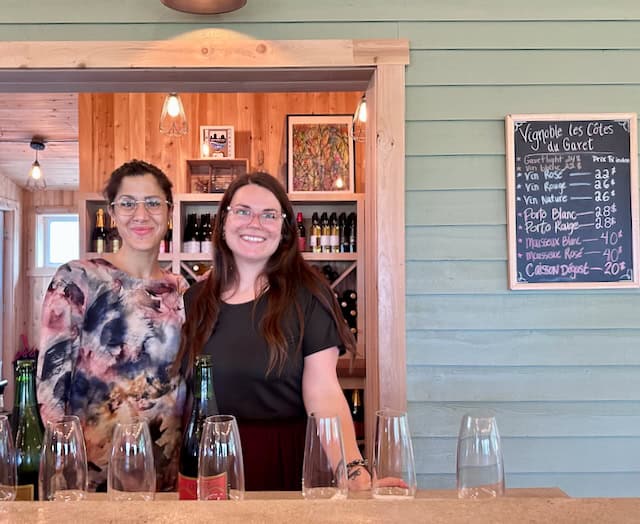
The wines were accompanied by delicious cheese from Fromagerie du Presbytère. Their award-winning cheeses are produced nearby by the Morin family using milk from their dairy farm, Ferme Louis d’Or, and aged in a former church, which retains a small chapel for worship. Our cheese platter featured Louis d’Or aged 24 and 36 months, Religieuse, Bleu d’Elizabeth and Laliberte. I’d love to visit their shop in St. Elizabeth du Warwick during one of their famous Friday summer picnics, featuring live music and open to all.
Poutine!
Poutine is almost synonymous with Québec and at the Musee des Cultures du Monde we learned all about this beloved regional dish and its controversial beginnings. We discovered how the iconic dish which is traditionally made from French fries, gravy and cheese curds, has been adapted globally to reflect local tastes in nearly every corner of the world.
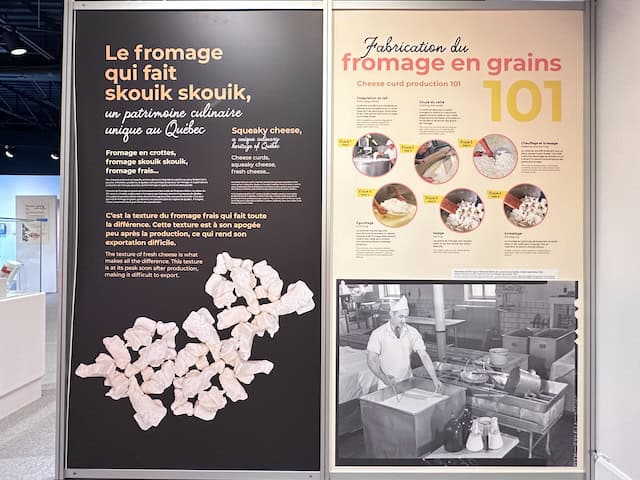
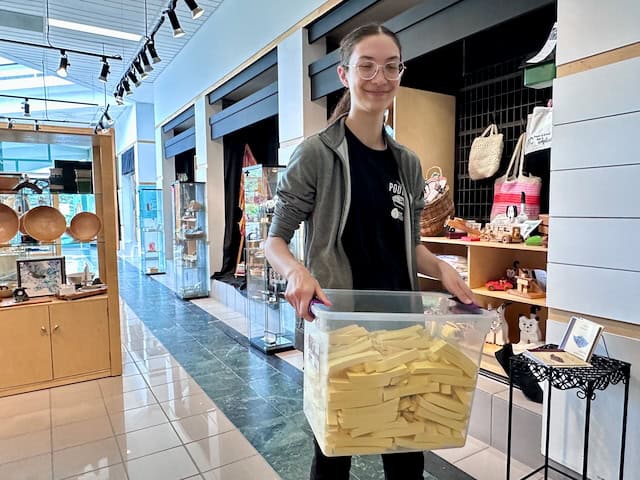
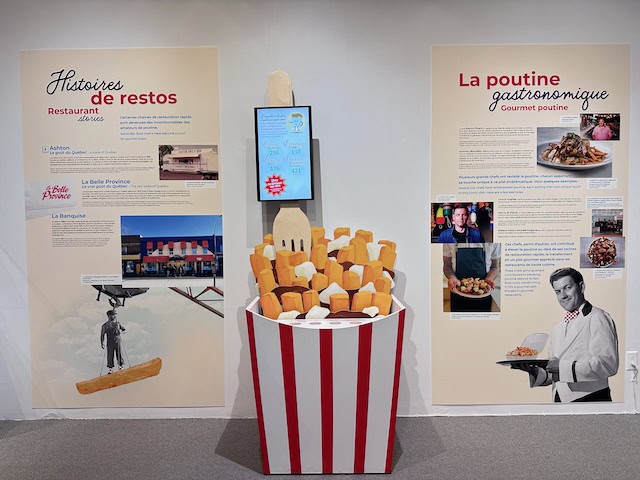
We had fun voting for our favorite origin story and most important ingredient using giant plastic French fries. The only thing missing here was actual poutine, which I think we were all craving at the end of the exhibit, but the poutine-themed merch in the gift shop was impossible to resist and made up for missing the tasty dish.
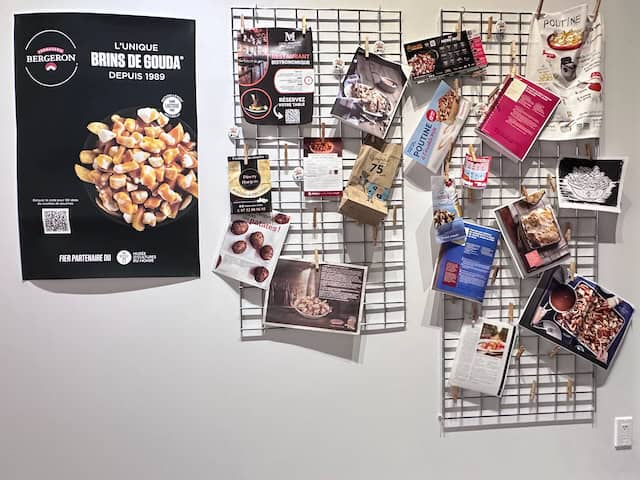

Poutine: A Culture of all Flavors is a special exhibition and closes September 28 but there is more to see at this small museum in the Centre-du-Québec.
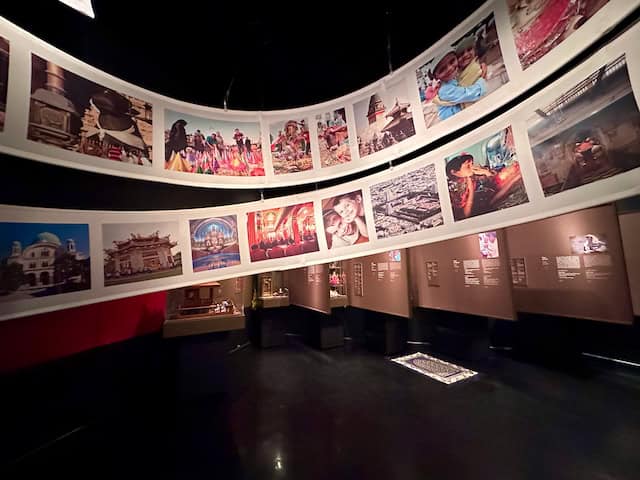

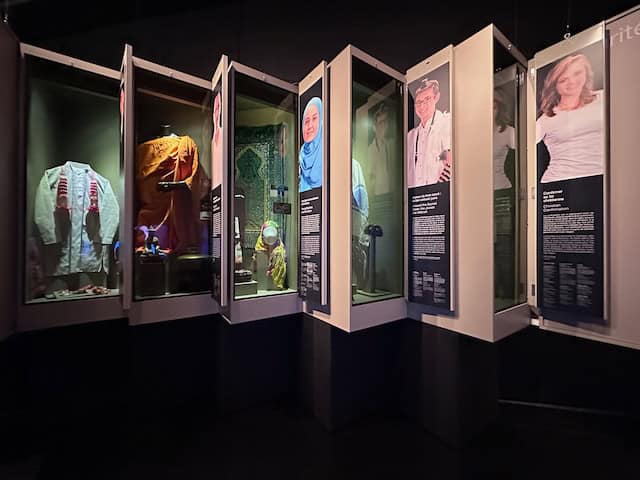
The museum has ongoing exhibitions about world religions including a massive display of Barbie dolls illustrating wedding customs from many cultures.
Elevated Cuisine at Au Paturage
Au Paturage roughly translates to at the pasture and the restaurant is indeed surrounded by agricultural fields and flower- filled meadows. The elegant Au Paturage- Espaces Gourmand,
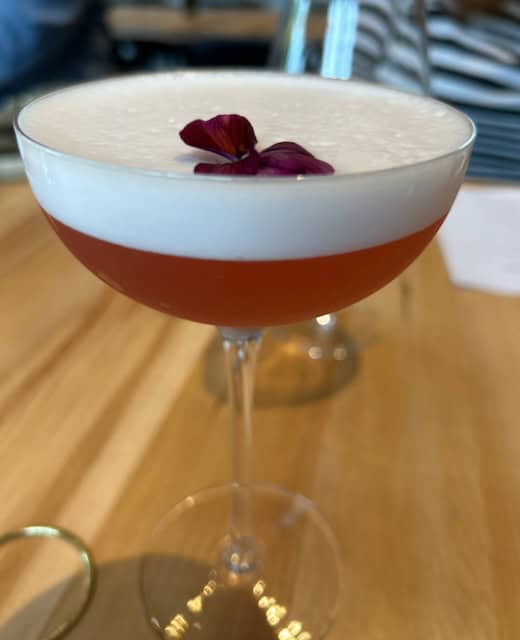
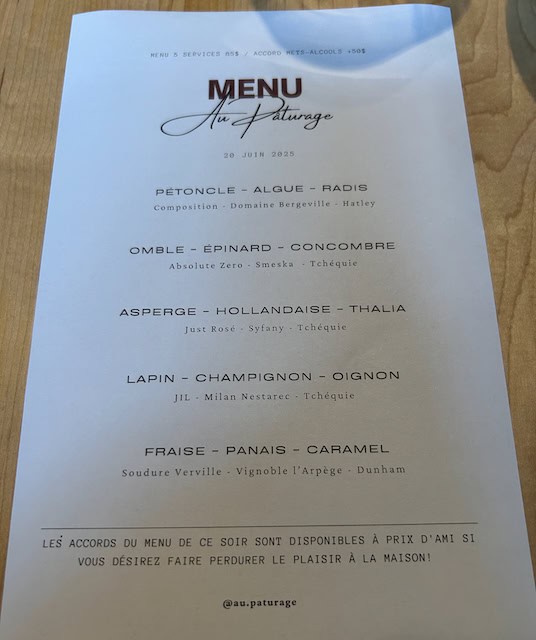
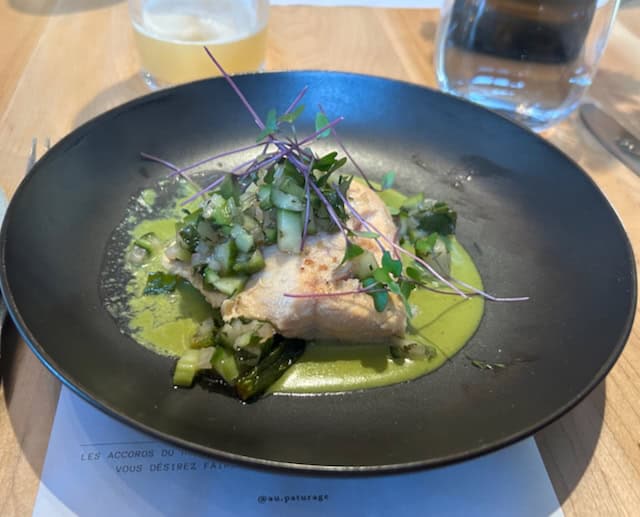
focuses on seasonal, locally sourced foods, including produce grown on their own three-acre farm, right outside the restaurant. Their cheese comes from Fromagerie Presbytère and meat from Ferme le Roy du Cerf. After a welcome cocktail, it was time to taste the vegetable-forward menu.
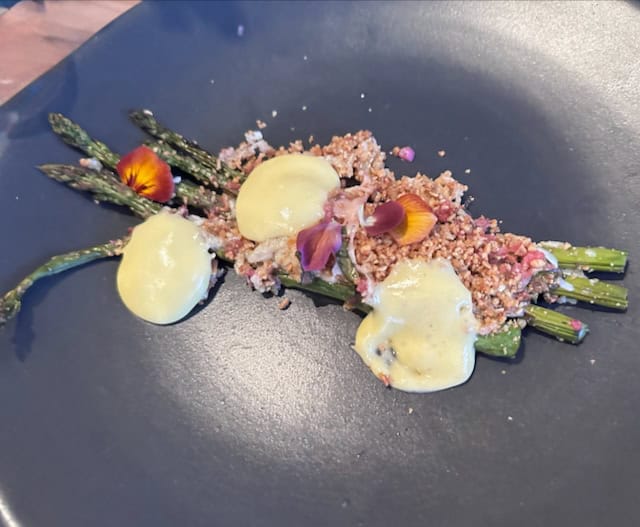
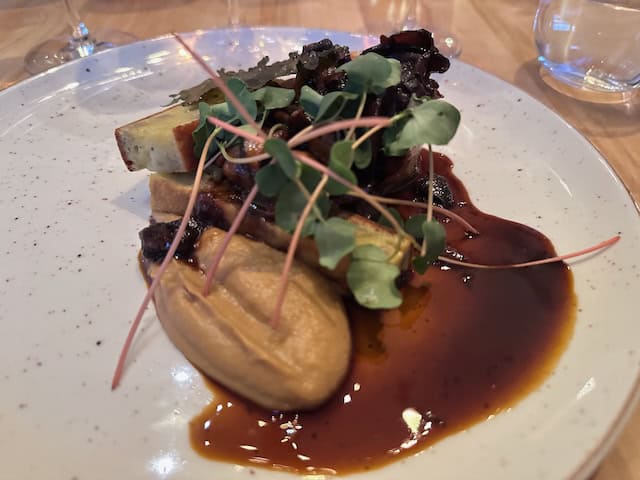

Prepared in the open kitchen by Chef Chloe Ouellet, the meal was spectacular and interestingly, was paired with wines from Québec and Eastern Europe. During summer, their dog-friendly 55-seat terrace is open. Be sure to make a reservation.
The (Very) Old Mill
After a night at Hotel Montfort in Nicolet, it was time to move on to Bécancour and a visit to the historic Moulin Michel which has been grinding buckwheat into flour since 1743 in the traditional manner. The current mill has been operating in the Centre-du-Québec since 1774, after a fire destroyed the original mill.

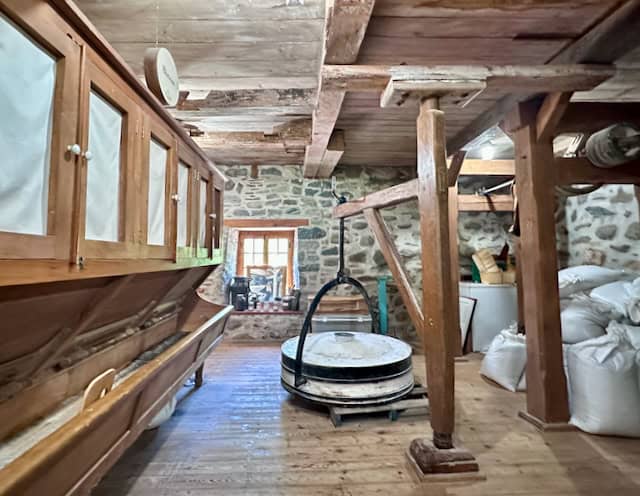
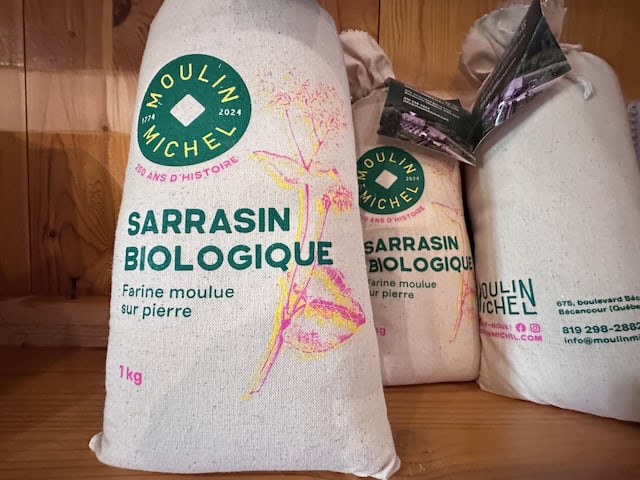
We had the opportunity to see the hydraulic mechanism and learn about the fascinating history of buckwheat, the 18th century mill, and the area, from owner Philippe Dumas. Fun fact, in lieu of cash, farmers left a portion of their grain as payment to use the mill, which was available to everyone.

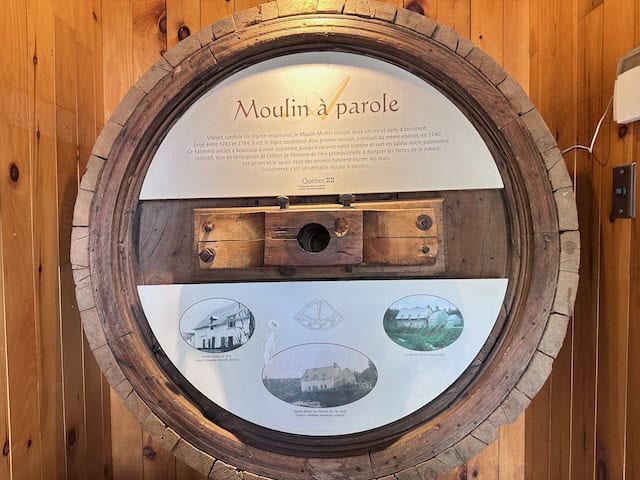
Inside the historic mill building you’ll find a café and shop with delectable pastries, coffee and local products for sale. In the evening it becomes a bar.


During summer months, the sprawling grounds behind the mill are transformed into an entertainment venue and hosts a Blues Festival, now in its fifth year, that draws 1,200 people to this town of 2,000.
Take a Hike or Bike
We needed to walk off all those goodies and did so with a guided hike at the beautiful Parc des Sommets, a popular natural recreation area in Bromont in the Eastern Townships. In summer, the 150 kilometers of hiking trails draw outdoor lovers of all ages and abilities. It’s also a great place to bike. Let the kids try out the climbing wall or just enjoy a picnic here.


Southern Québec boasts six national parks perfect for outdoor endeavors like hiking, biking and kayaking during lazy summer days and snow sports of all kinds when the winter weather beckons.
L’Espace Old Mill
Having met our exercise goal for the day, it was time for dinner at one of the toughest tables to get in the Eastern Townships; L’Espace Old Mill.
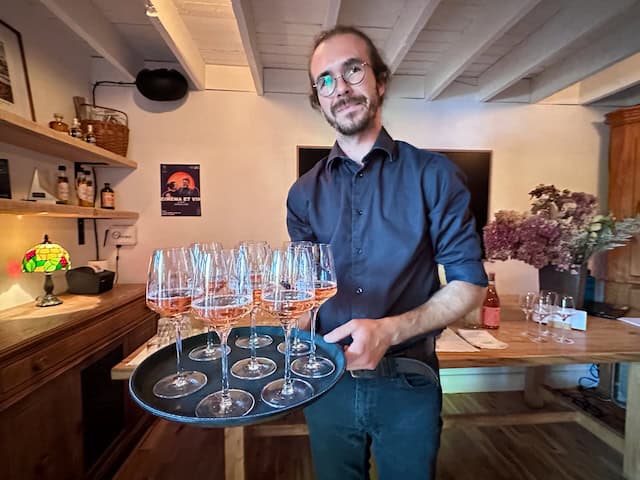

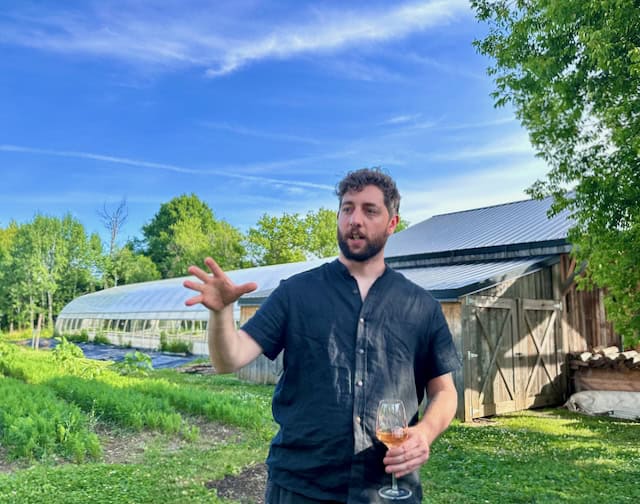
Inspiration and education are on the menu at this extraordinary restaurant that serves only what grows in its greenhouse and gardens (even in Québec’s frigid winter months) and what it can procure from nearby farms. We enjoyed a glass of local sparkling wine while we toured the expansive gardens with Executive Chef Eric Gendron before heading inside the airy dining room to feast on summer’s bounty.

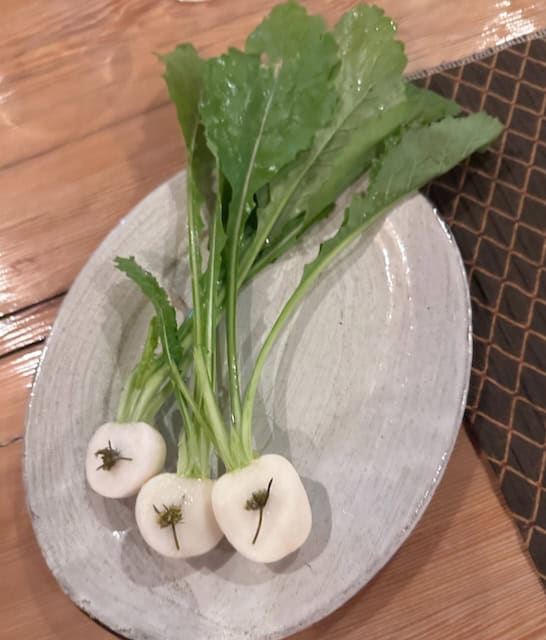

The hyper-local focus is on the cuisine of the Brome-Missiquoi region here. Farmer/owner Jean-Martin Fortier came by and shared his vision for L’Espace Old Mill and their ongoing commitment to sustainable and regenerative farming, widely embraced by farmers in the Eastern Townships.
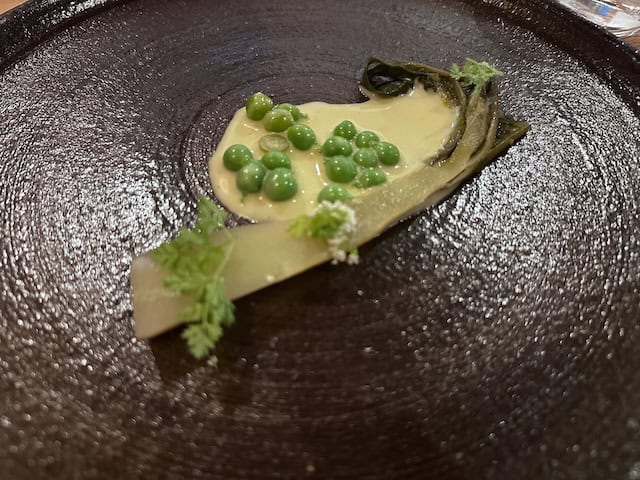

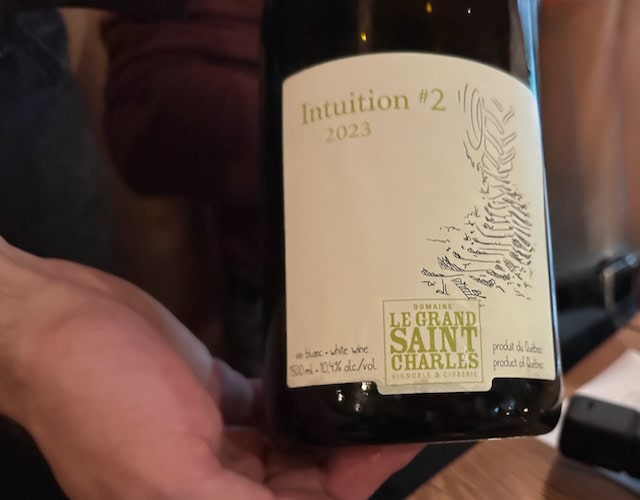
The Michelin Green Star-awarded restaurant’s menu is naturally vegetable-forward, though not vegetarian. I don’t think I have ever had peas or radishes that tasted so sweet and delectable! The wines poured to match the courses were also local. After a remarkable meal, we were off to nearby Hotel Chateau-Bromont, our lux and comfortable home for the night.

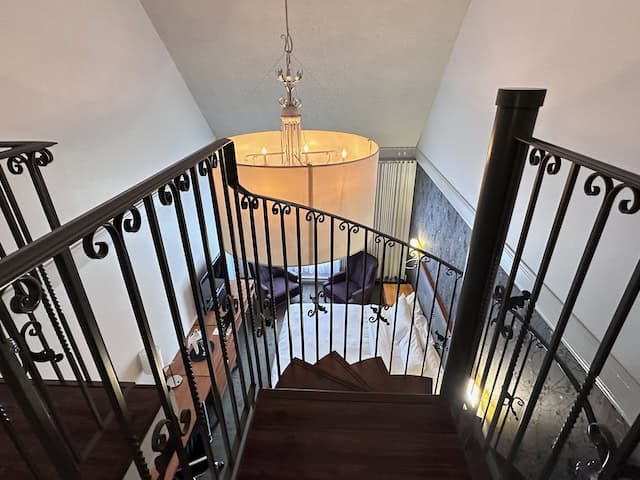
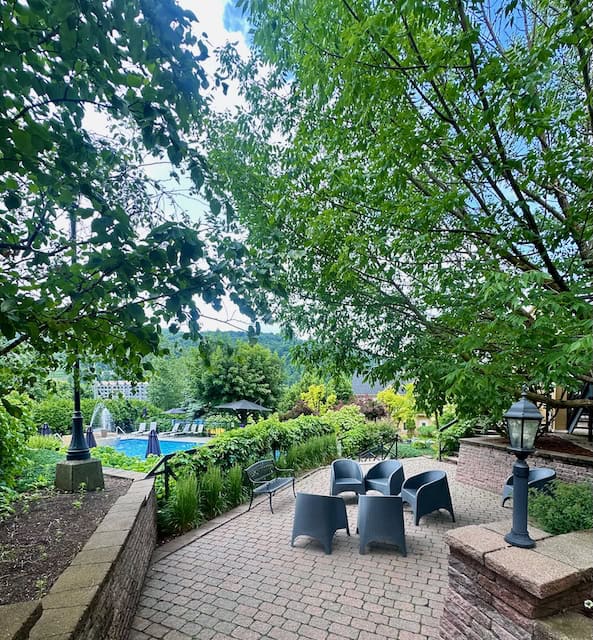
We had a beautiful bi-level room at Hotel Chateau-Bromont with a gorgeous view of the mountains. After our abundant breakfast, we explored the property, wishing we had more time to lounge around the spa and pool area. We need a return visit to take advantage of the wellness offerings here and revisit the beautiful nature park! Another dinner at Old Mill would be wonderful, too.
Beer and Brunch
It was time to move on to the charming town of Dunham and the Brasserie Dunham, which brews its own beer. We took a table in the outdoor beer garden and finally, poutine was on the menu! We couldn’t resist ordering a plate to share.



Hearty sandwiches, salads, burgers and other beer-friendly fare make the Brasserie popular for lunch and dinner. The brewery offers beers from blonde lagers to IPAs to seasonal ales and stouts. Our group sampled several. Our wonderful driver Dave was behind the wheel so were able to indulge in adult beverages.
On the Wine Route
Our stomachs full, we headed out to explore the wine route of Brome-Missisquoi where about 60 percent of Québec’s wine is produced. Now home to more than 20 wineries, the 160-kilometer route winds through beautiful countryside, rolling hills and several pleasant towns in the Eastern Townships. There are itineraries for cars and bicycles available.

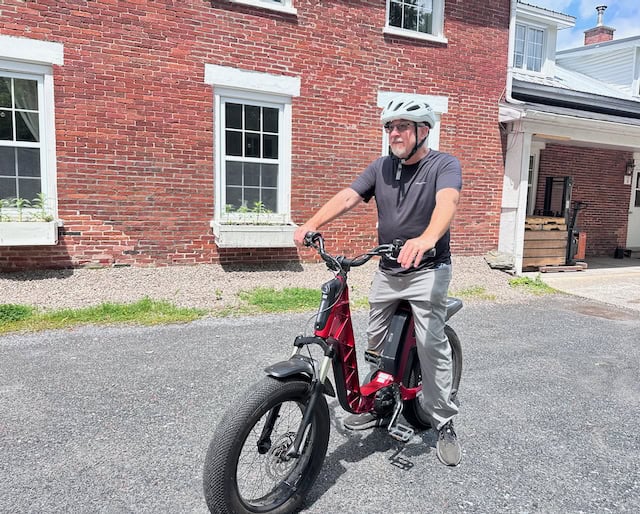
Our first stop was at Domaine du Ridge, a 200-acre property that includes fields, woodlands and 40 acres of vineyards. It’s a popular venue for weddings and other special events. Tours and tastings are by reservation at this 26-year-old winery.
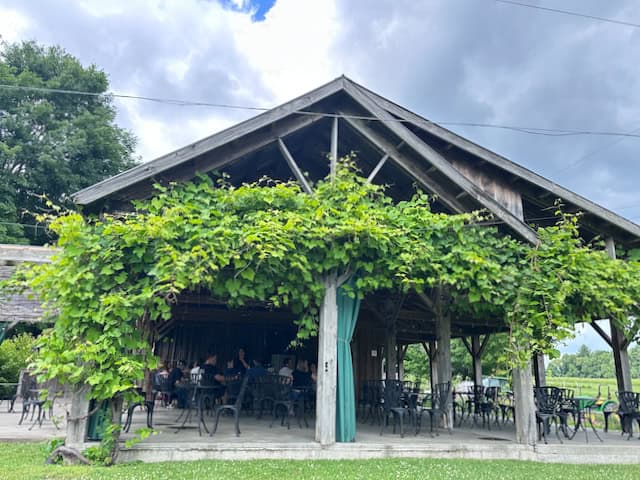
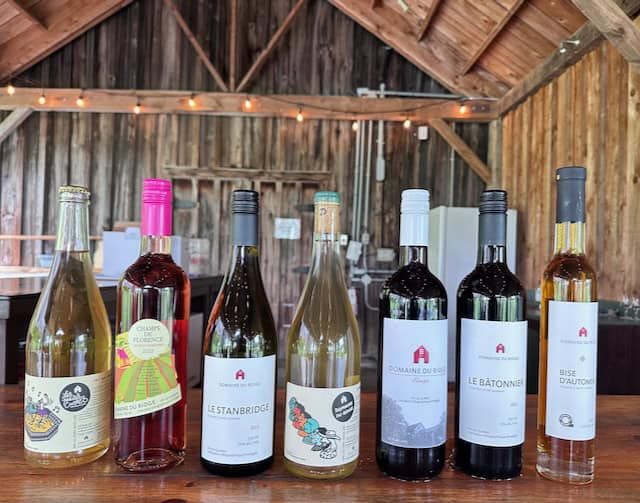
In addition to still and sparkling wines, Domaine du Ridge produces a late harvest made with Vidal Blanc grapes called Bis d’Automne (Autumn Kiss), a dessert wine in the style of Pineau des Charentes, and Mystic, a vermouth. After sampling several still wines from their recent vintage it was time to move on to Vignoble de l’Ardennais.



You’ll know you have arrived at Vignoble de l’Ardennais when you see the giant bunny painted on the garage. This was my favorite, both for the wines and the charming owner, Pier Cousineau, who with his wife Stephanie Thibodeau, and adult children Charlotte and Eliot, run every facet of wine production from label design to vinification.
Other than Pinot Noir and Riesling, the grape varieties used here were unfamiliar to me. Seyval Noir, Chancellor, Petite Pearl, Frontenac Noir, Cayuga, and Marquette are hardy hybrid varietals that grow well in the often unforgiving Québec climate. Monsieur Cousineau uses them to full advantage to produce excellent wines and has been since 2016 when they acquired the property. The vineyards had been established by the previous owner in 1994. Grab a glass of Berthe rose and relax in the Adirondack chairs or picnic tables. That’s my idea of a perfect summer Sunday afternoon.
Dining en Plein Aire
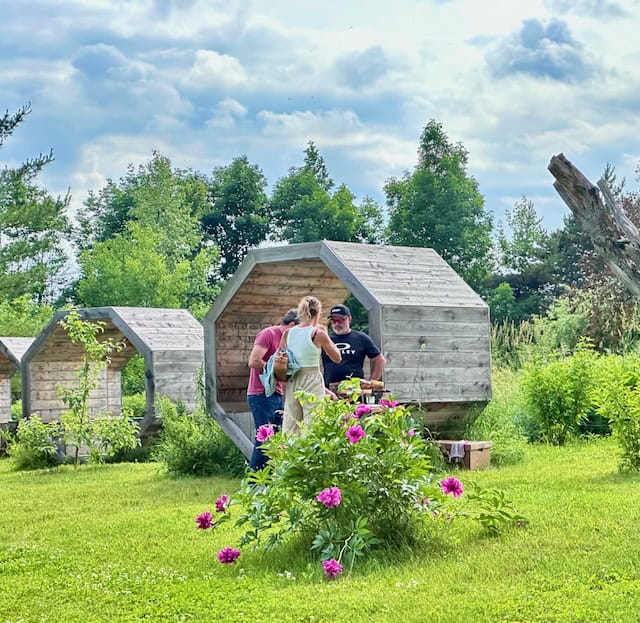

It was a pleasant surprise to find that our Sunday dinner at Les Cocagnes in Frelighsburg would be prepared by chefs Emile Trembly and Sylvain Dervieux from Faux Bergers in Baie St. Paul, where we had spent the weekend before arriving in Québec City.
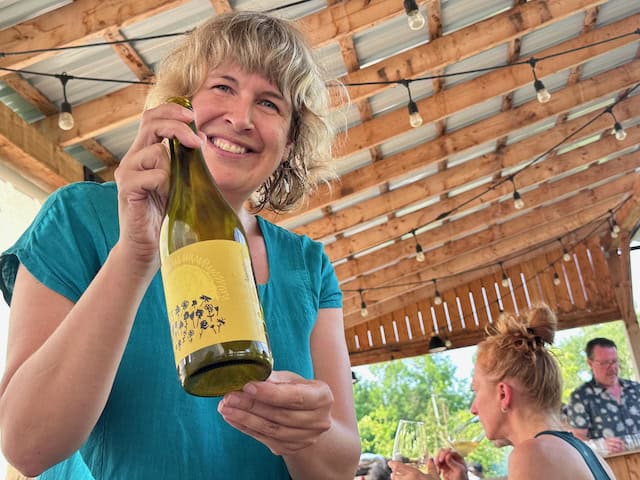
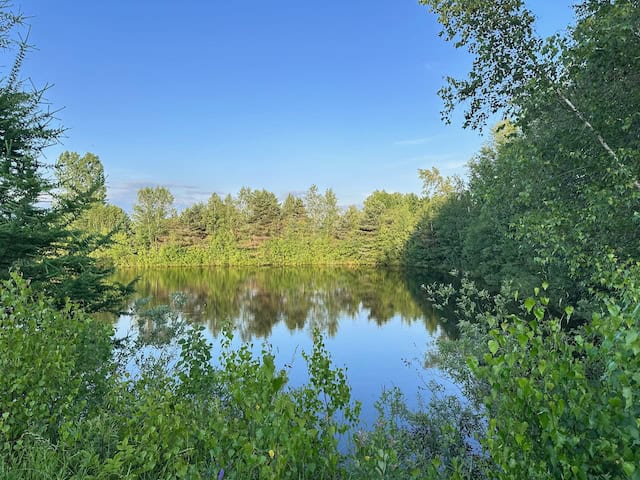
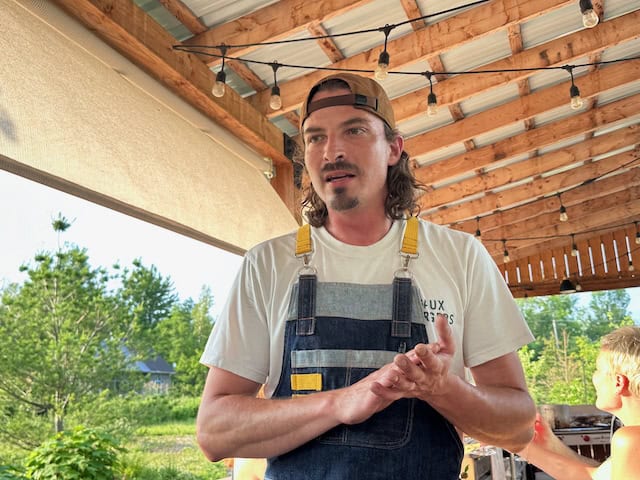
Each summer weekend, chefs from throughout Québec set up shop at this bucolic spot in the Eastern Townships. After an aperitif and hand-sliced local prosciutto, we followed our hostess through the fields and vegetable gardens to the outdoor dining room for a memorable five-course tasting menu paired with local wines. Reservations are essential.


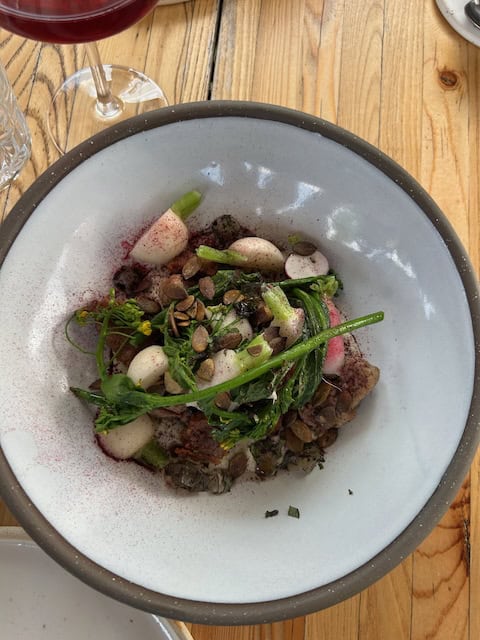
It was time to leave the Eastern Townships for Montérégie. La Cache du Lac Champlain across the street from Lake Champlain was our home for the evening. After depositing our bags in our large room with a golf course view, we headed out for a moonlight walk along the lake.

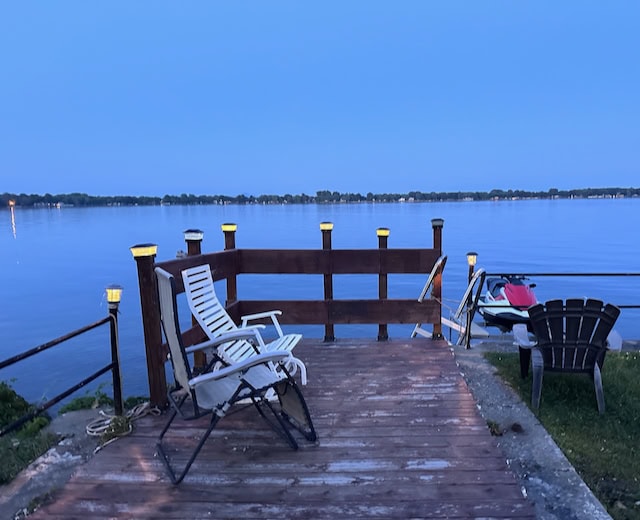
We couldn’t resist a local ice cream stand a few blocks away and enjoyed our cones while admiring the public art and private terraces along the lake front. These terraces, with outdoor furniture and boat docks, dot the lakefront while the homes are across the road.
Les Amoureuses (The Lovers) by Veronique Pepin and Patrick Monast has space inside for two. It is the first work in a public art installation in Venice-en-Québec and will be on view through May 2026.
Ferme Guyon and Bonne Saint Jean
We heard people at breakfast greeting each other with “Bonne Saint Jean.” Saint Jean Baptiste (John the Baptist) is the patron saint of Québec, and the Fete de la Saint Jean is a national holiday in the province. This called for a slight change of plans and a trip to Ferme Guyon.
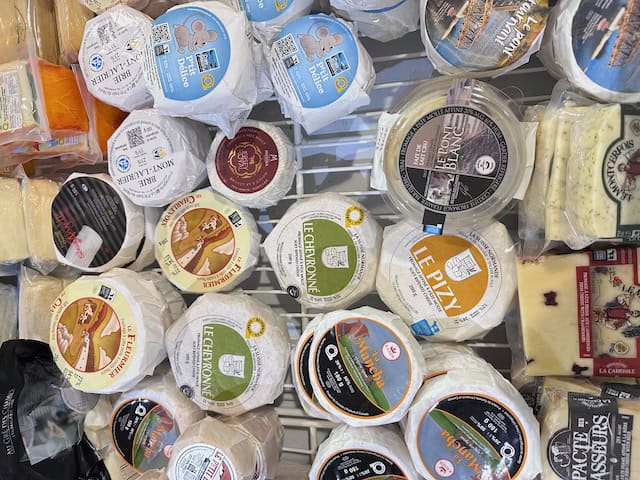

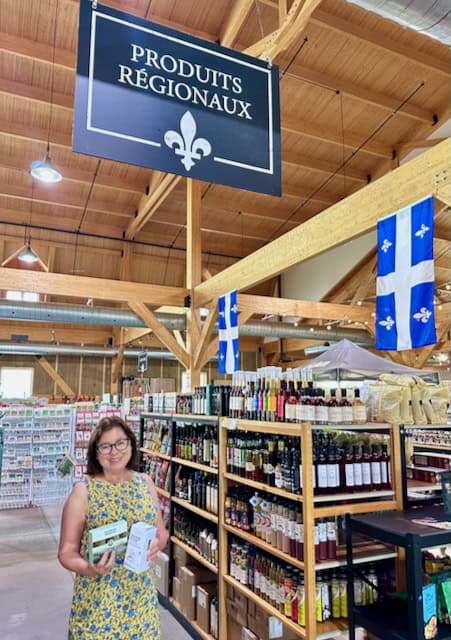
Just 30 minutes from Montreal, this is the supermarket of my dreams. Farm-fresh produce, fine cheeses, charcuterie, maple sugar everything (cotton candy!), and an extensive selection of local ciders, beer and wines, plus Québecois handicrafts make this a one-stop shop for picnic provisions or any meal you’d want to prepare. If you don’t have time to visit local fromageries, wineries and farms, a trip here will definitely give you a taste of local flavors!
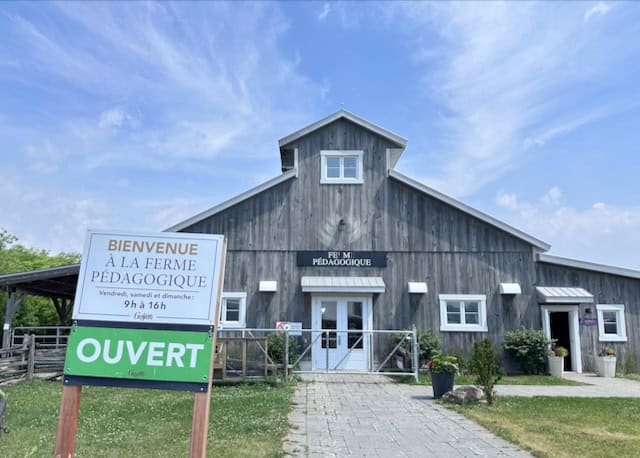


The Ferme Guyon also has an educational farm with adorable baby animals and a butterfly pavilion, which in addition to housing lepidoptera, is the habitat of Oscar, a 14-year old tortoise. I could have spent the whole day here, but shopping completed, we headed off to Cidrerie Michel Jodoin on the Rougemont Cider and Montérégie Wine Route.
Cider and More Wine
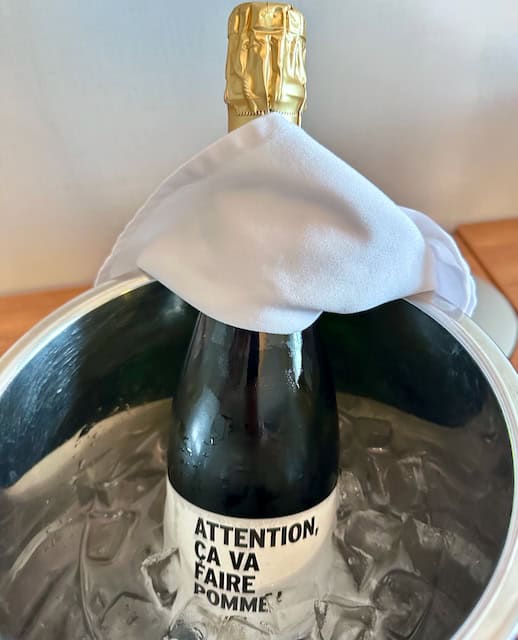
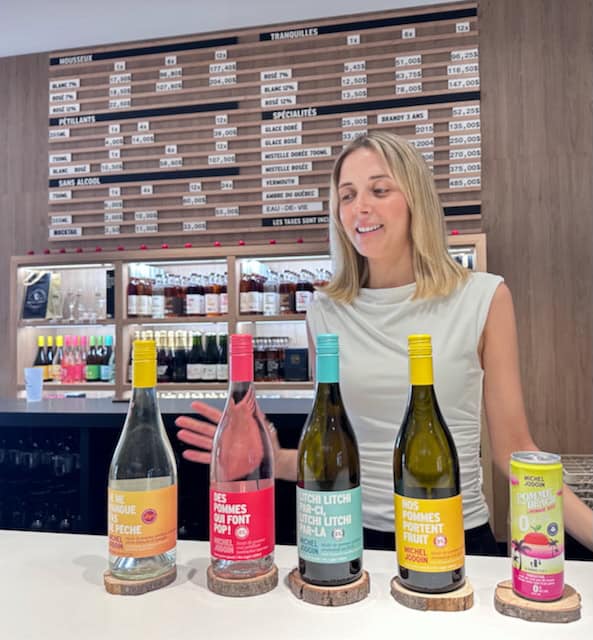

I adore champagne and was intrigued to learn that Monsieur Jodoin had worked in France’s Champagne region in the 1980s and returned to Québec with a plan to make a sparkling wine from apples using the traditional methode champenois. His family has been in the apple orchard business for five generations, ever since Jean-Baptiste Jodoin purchased 100 apple trees in 1901. Jodoin is now the largest grower of Geneva apples in North America.
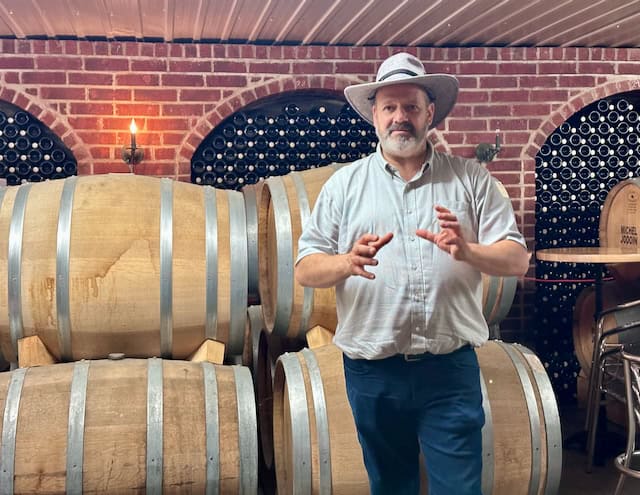
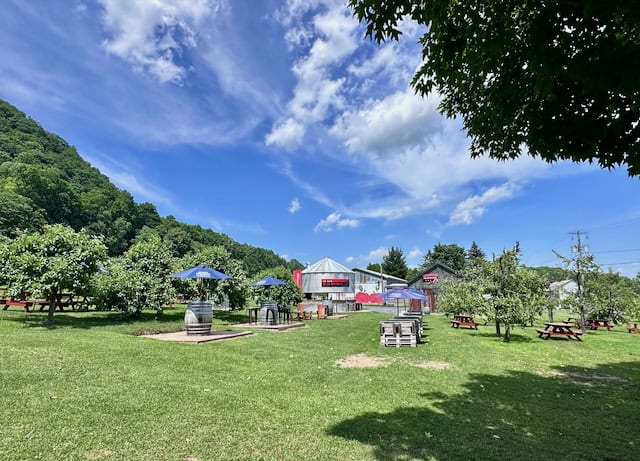
Their award-winning ciders were delicious, and we enjoyed them thoroughly with our picnic lunch in the cidery’s cellars. My favorite was Attention Ca Va Faire Pomme! It’s packaged to look like champagne and captures the wine’s characteristics right down to the perlage or tiny bubbles in the glass. Jodoin makes several refreshing roses from apples, a broad range of fruit flavored ciders, vermouth, and non- alcoholic drinks. They became the first micro distillery in the country in 1999 and we tasted their spirits, too. No reservations are needed to visit the Cidrerie Michel Jodoin tasting room. Visitors are welcome to enjoy their picnics outside and can access the hiking trails here. During the summer their grounds are often the site of evening entertainment.



Next, we stopped into Coteau Rougemont just down the road from Jodoin, to sample their wines. The winery was quiet due to the holiday, so we enjoyed a leisurely tasting outdoors overlooking the beautiful gardens and rolling hills of Montérégie. They also sell local honey, jams and maple syrup at the winery.
Spaaaah
It was time for a break. Bonjour Québec arranged a wonderful afternoon of complete relaxation at Strom Spa Nordique. The thermal waters and serene surroundings are the draw here and we took full advantage, moving from one temperature- controlled pool to another on the recommended circuit. After several hours of blissful soaking, it was dinnertime.
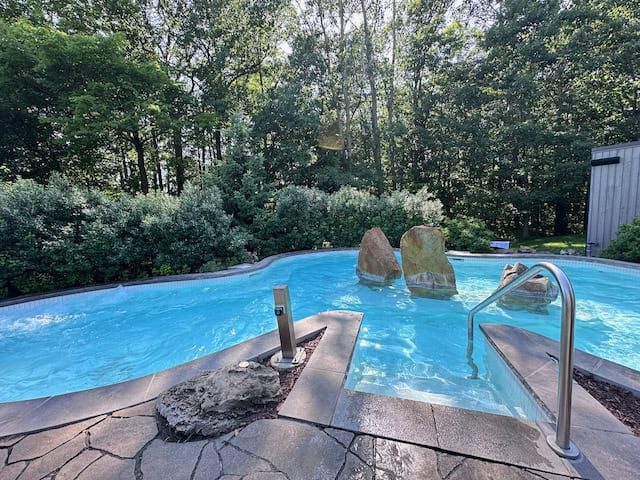

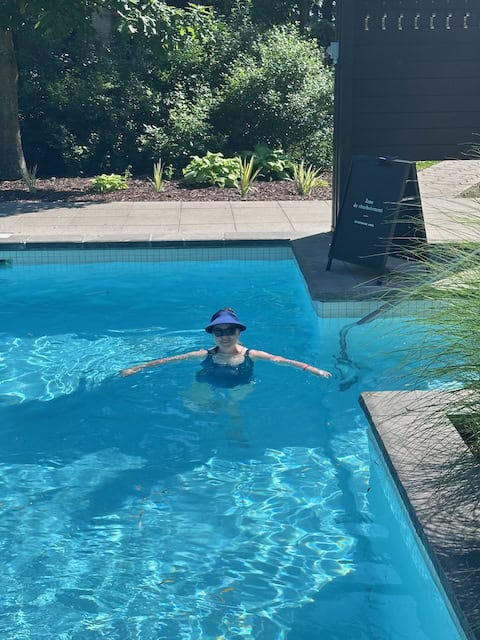
The menu at Bistro Nord at the Strom Spa spotlights artfully and healthily prepared local produce and every course was both. Executive Chef Raphael Podlasiewicz came out to describe each delicious dish to us. Reservations are required at the Strom Spa Nordique locations throughout Québec and in their restaurants as well.
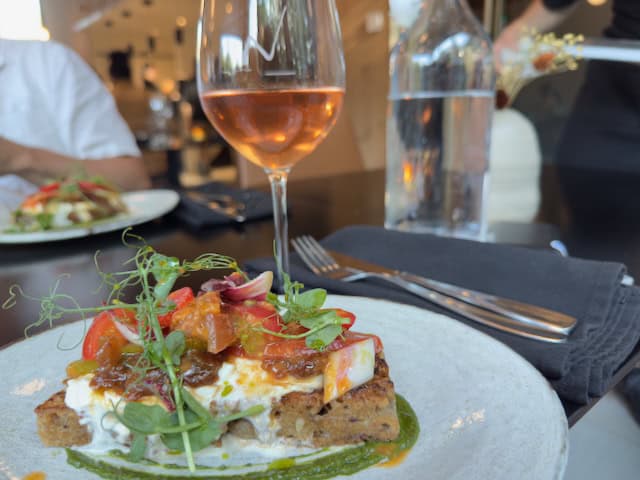
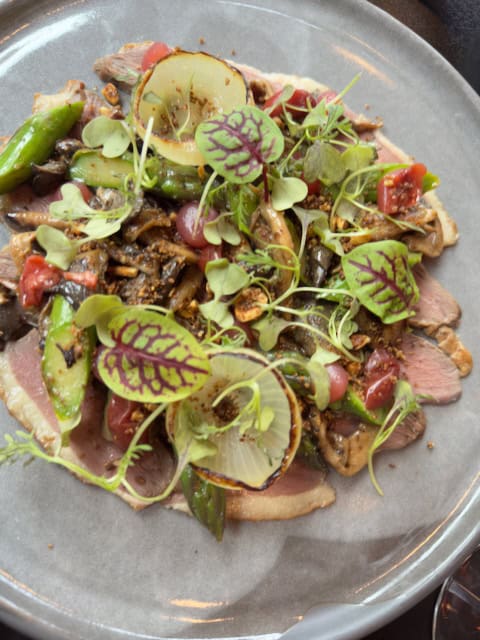

We spent our last night in Québec at the Hotel Rive Gauche, just 20 minutes from Montreal. The hotel is on the Richelieu River, and we were able to see a bit of the Fete de la Saint Jean fireworks launched further upstream.
Sugar Shack
Our last stop on our extraordinary epicurean adventure was a visit to Sucrerie de la Montagne. This traditional “sugar shack” has been a site for maple syrup production in Montérégie since the 1930s and has been owned by the Faucher family since 1978. Unlike most, it is open all year long, not just March to April during the “sugaring off” season. Owner Steven Faucher (shown above in front of a photo of his father) showed us where and how they make syrup.
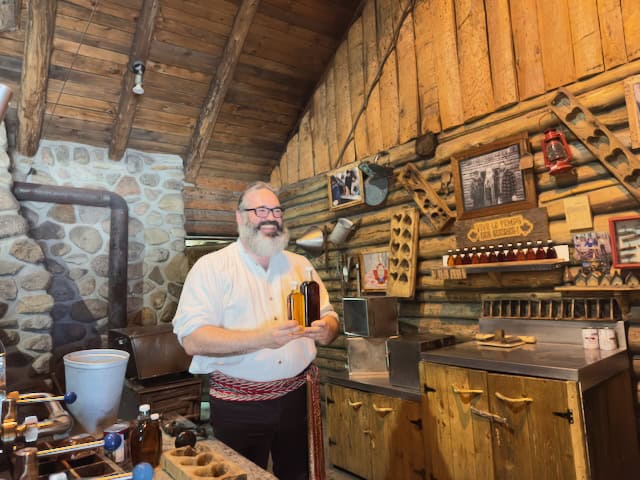

We learned how trees are tapped using a spout and bucket and the “maple water” collected and turned into syrup. It takes 40 gallons of maple water to make one gallon of light or amber (medium) syrup, and 50 gallons to make a gallon of dark syrup! Amber is the most popular grade of syrup.
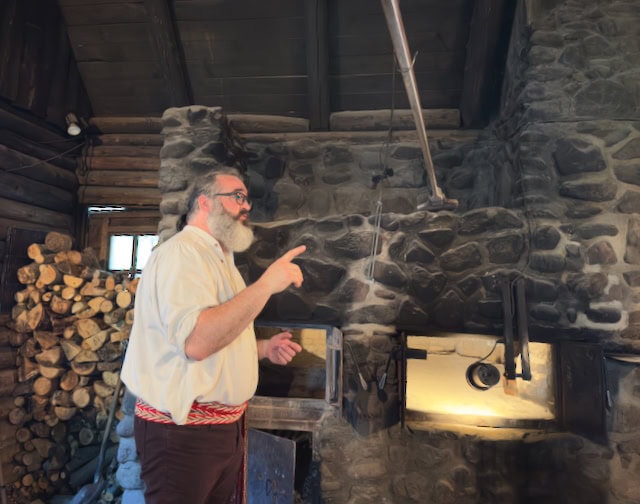
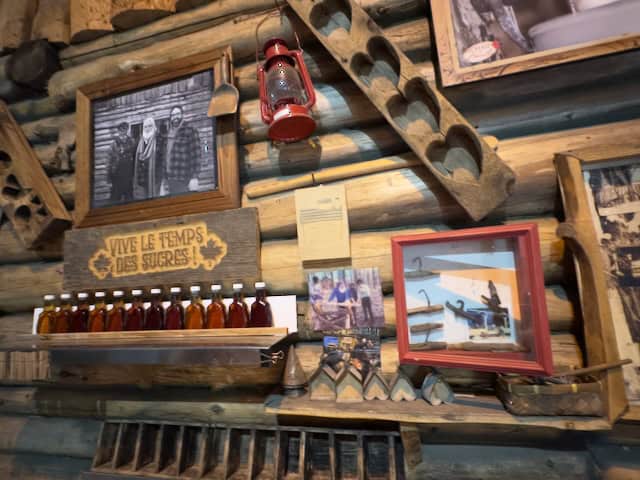
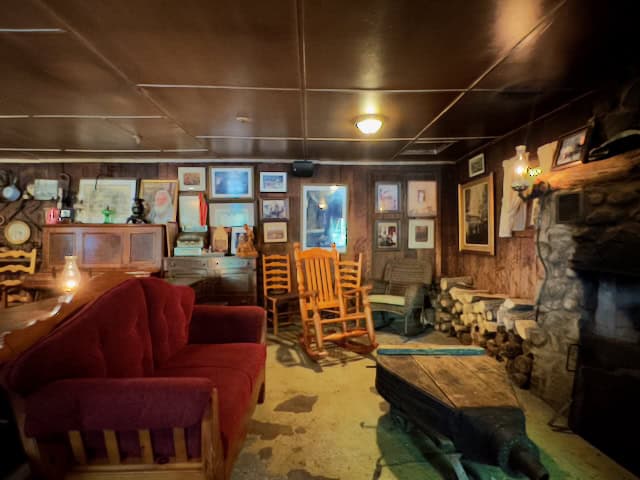
We also visited the massive oven, which was purpose-built in 1982 for bread baking and requires two bakers working six days a week to make enough loaves to feed workers and guests during the maple sugar season.
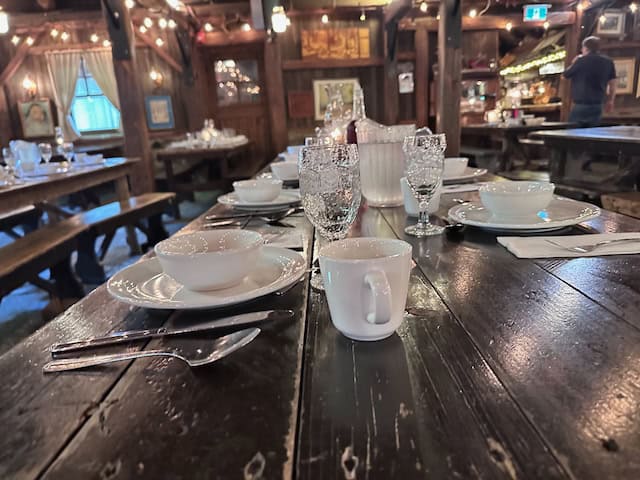

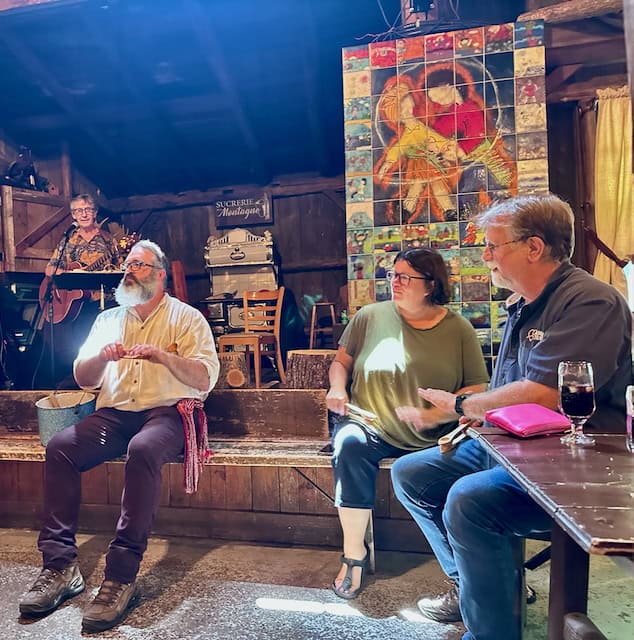
After finishing our tour of the buildings, we settled into their popular restaurant for a hearty meal, served with maple syrup made at Sucrerie de la Montagne, of course. During lunch we were entertained by live traditional Québecois music and afterwards given a lesson in playing the spoons by our jovial and charming host. Depending on when you visit, you may even see an axe-throwing demonstration near the general store, which has a wide selection of local goods, handicrafts and maple syrup products. Some syrup and tea towels made it into my suitcase!
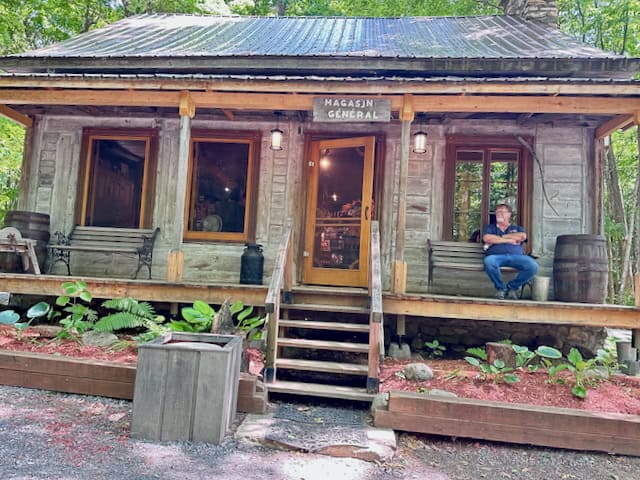
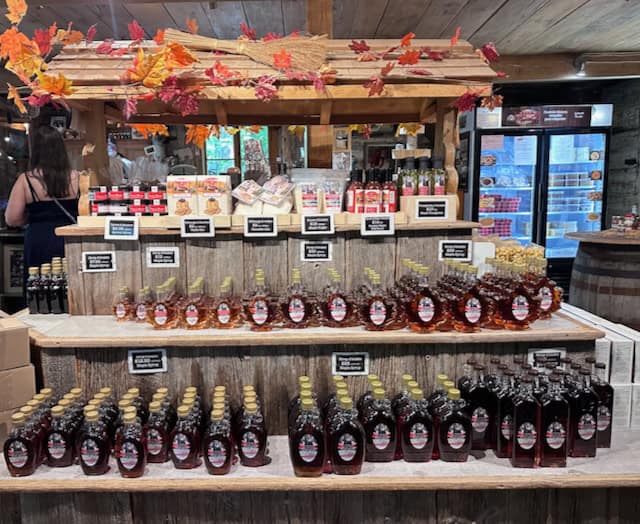

Our journey through Southern Québec was an unending series of delight and surprise, from the gorgeous countryside to the incredible cuisine. What will really stay with me is the warmth, generosity, and hospitality of the people I met in Centre-du-Québec, the Eastern Townships and Montérégie. Despite recent political tensions between our countries, the Québecois are wonderfully welcoming. Take them up on their offer to, “Come to the Eastern Townships and hug it out!”
Written and photographed by Jeanne Neylon Decker
Protected by US Copyright Laws.
This post contains affiliate links. If you click and book, I
may earn a commission at no extra cost to you. I promise not to spend it all on ice cream. Thank you. I appreciate it!

